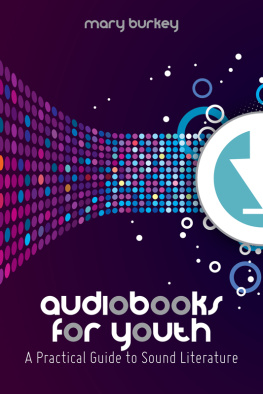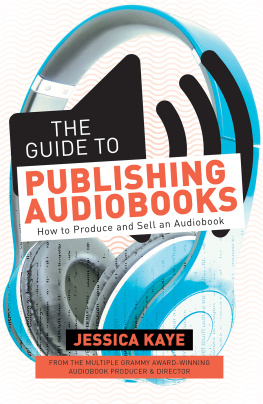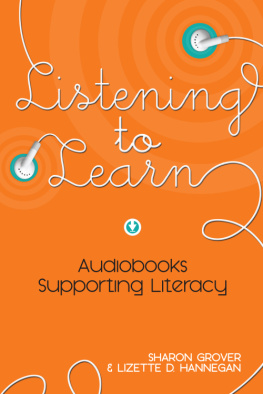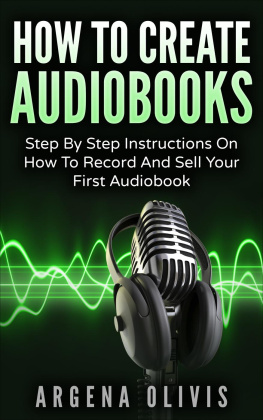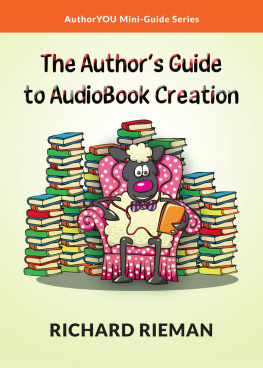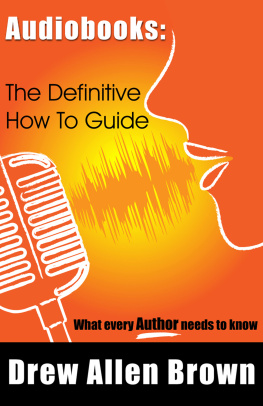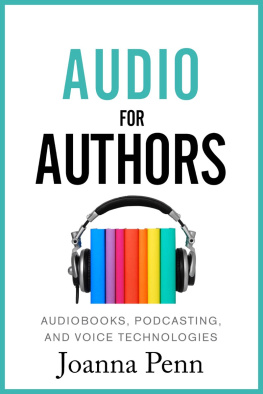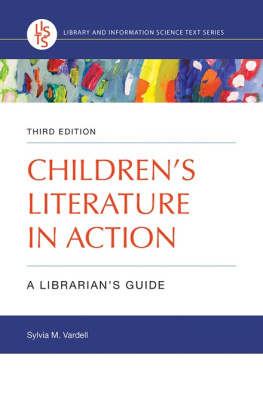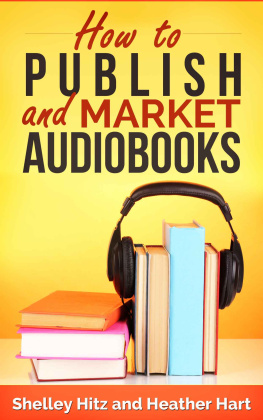Audiobooks for Youth
ALA Editions purchases fund advocacy, awareness, and accreditation programs for library professionals worldwide.
Audiobooks for Youth
A Practical Guide to Sound Literature
Mary Burkey

An imprint of the American Library Association
CHICAGO 2013
MARY BURKEY is a National Boardcertified teacher-librarian from Columbus, Ohio. She is the past chair of the American Library Associations Notable Childrens Recordings, was part of the Odyssey Award Task Force, and served as the chair of ALAs first Odyssey Award for Excellence in Audiobook Production Committee. She currently serves as a judge for the Audio Publishers Associations Audie Awards, reviews for Booklist magazine and The Horn Book magazine, and writes Booklists audiobook column Voices in My Head. Her Audiobooker blog (http://audiobooker.booklistonline.com) serves as an online scrapbook of audiobook minutiae, digital literature ramblings, and reflections on audio productions and performances.
2013 by the American Library Association. Any claim of copyright is subject to applicable limitations and exceptions, such as rights of fair use and library copying pursuant to Sections 107 and 108 of the U.S. Copyright Act. No copyright is claimed for content in the public domain, such as works of the U.S. government.
Extensive effort has gone into ensuring the reliability of the information in this book; however, the publisher makes no warranty, express or implied, with respect to the material contained herein.
ISBNs: 9780-8389-1157-0 (paper); 978-0-8389-9587-7 (PDF); 978-0-8389-9588-4 (ePub); 978-0-8389-9589-1 (Kindle). For more information on digital formats, visit the ALA Store at alastore.ala.org and select eEditions.
Library of Congress Cataloging-in-Publication Data
Burkey, Mary.
Audiobooks for youth: a practical guide to sound literature / Mary Burkey.
pages cm
Includes bibliographical references and index.
ISBN 978-0-8389-1157-0 (alk. paper)
1. LibrariesSpecial collectionsChildrens audiobooks. 2. Childrens audiobooksUnited States. I. Title.
Z688.A93B87 2013
025.2'882dc23 2012022639
Cover design by Kirstin Krutsch. Cover images Shutterstock, Inc.
Dedicated to the members of the audiobook community who so willingly shared their expertise and personal reflections, with gratitude and appreciation
Contents
A History of Childrens Audiobooks
ONCE UPON A TIME, there was the word. The word was shaped into the sound of story and flowed through time and place, carried by the tellers voice. In daily life, spoken word served as the foundation of culture. Mother soothed her child with story; heroes were immortalized in legend; elders passed along their knowledge of the land through myth and tale. As sound took shape on the page, teachers and students recited lessons together, while religious leaders chanted holy words. The very act of reading was a social activity until the end of the Middle Ages, as the literate processed the meaning of text aloud until Western society instituted the practice of private reading. Well into the twentieth century, reading remained an aural activity as the newest serialized Sherlock Holmes tale was read aloud in the family parlor and Mark Twain traveled the country reciting his books on stage. Much of the language of literature recognizes this oral tradition; we speak of an authors voice, a works intended audience, the writers tone, narrative sequence, and rhetorical mode. The sound of story serves as a constant throughout history, conveyed by bard, safeguarded in script, captured by recording device, and transmitted by digital signal. Audiobooks connect us to literature in its original form, returning the listener to the virtual storytellers circle.
Thomas Edison envisioned the power of aural literature to educate as well as amuse when he described the practical uses for recorded sound in his 1878 North American Review article The Phonograph and its Future:
Books.Books may be read by the charitably inclined professional reader, or by such readers especially employed for that purpose, and the record of such book used in the asylums of the blind, hospitals, sick-chamber, or even with great profit and amusement by the lady or gentleman whose eyes and hands may be otherwise employed; or, again, because of the greater enjoyment to be had from a book when read by an elocutionist, than when read by the average reader. The ordinary record sheet, repeating this book from fifty to a hundred times as it will, would command a price that would pay the original reader well for the slightly increased difficulty in reading it aloud in the phonograph.
Educational Purposes.As an elocutionary teacher, or as a primary teacher for children, it will certainly be invaluable. By it, difficult passages may be correctly rendered for the pupil but once, after which he has only to apply to his phonograph for instructions. The child may thus learn to spell, commit to memory a lesson set for it, etc.
With a stretch of the imagination, Edison might be credited with recording the first childrens audiobook more than a century ago when, as he explains in a sound clip available on Project Gutenberg, Sarah Josepha Hales poem Mary Had a Little Lamb was selected as the first experimental recording on his original tin cylinder phonograph in 1877.
Talking Books Evolve
The publishing trade saw the first true combination of book-plus-recording in 1917 when Harper Columbia released The Bubble Book, a volume for children. This production was the twenty-sixth recording recognized by the Library of Congress National Recording Registry, established, as stated in the National Recording Preservation Act of 2000, to maintain and preserve sound recordings and collections of sound recordings that are The National Recording Registry citation reads:
The Bubble Books, published by Harper Columbia between 1917 and 1922, was the first series of books and records published together especially for children. Authors were Ralph Mayhew and Burges Johnson, while Rhoda Chase provided the beautiful, full-color line drawings. Each book contained three 5-inch discs to accompany the three nursery rhymes printed in the books. The singer is not listed on the discs, but is thought to be Henry Burr. Millions of the books were sold to delighted children in the U.S. and abroad.
The charming Bubble Book series featured illustrated rhyming text, ranging from Mother Goose to A Childs Garden of Verses, in child-sized books with color-illustrated pages, which were joined within the book to serve as disc sleeves for small records containing the sung and spoken text. A November 1919 advertisement in The Atlantic Monthly notes that Bubble Books were available for one dollar at any bookstore, Columbia Grafonoia store, gift shop, toy shop, music store, or department store while the 1919 Sears catalog priced the titles at 89 cents. A massive November 1920 promotional effort in book trade journals described Harper Columbias consumer push of the Bubble Books as the largest campaign ever devoted to books and created a rage for the recordings, which were marketed, despite copyright wrangles, into the early 1930s. In an early example of multimedia marketing, the vastly popular productions were endorsed by celebrity child actors, heralded at Bubble Book story times in bookstores, and played on the radio. The Bubble Books form the foundation of childrens readalong audiobooks, creating a model of text, image, and words plus music that continues into the twenty-first century.
Next page
